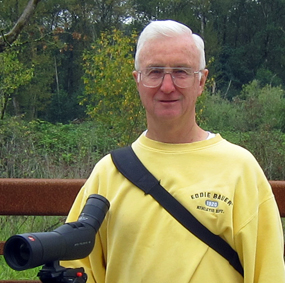

Join BirdNote tomorrow, November 30th!
Illustrator David Sibley and actor H. Jon Benjamin will face off in the bird illustration battle of the century during BirdNote's Year-end Celebration and Auction!
How do birdwatchers identify one species from another? First, they look carefully at the bird. What's the overall color? Is its bill long or short, thin or stout? What about its markings -- a ring around its eye or stripe on its head? What's your bird doing? Bird behavior can help you sort out one species from another. And where is your bird? What habitat? Red-winged Blackbirds, like the female seen here, are generally seen in marshy areas. Take notes, and you'll accumulate valuable knowledge to help you identify birds. Want to learn more about Red-winged Blackbirds? Check out Cornell's All About Birds.
BirdNote®
Birdwatching 104 –A Summary
Written by Chris Peterson
This is BirdNote!
Let’s eavesdrop on a group of birdwatchers exploring a freshwater marsh.
[Sounds of the excitement of the field trip; the sighting of the Green Heron and wetland sounds]
What exactly do birdwatchers watch? How do they identify one species from another?
Well, first, they look carefully at the bird. Don’t get caught up flipping through your field guide or app until you have a clear idea of what you’re looking for.
What’s the overall color? Is its bill long or short, thin or stout? What about the bird’s markings -- like a ring around its eye or stripe on its head?
What’s your bird doing? Bird behavior can help you sort out one species from another.
And where is your bird? What habitat? Like fishermen who know how to “read the water,” it helps to know where to look. You learn what to expect.
At a wetland full of cattails, for example, you’re likely to find a Red-winged Blackbird, singing from atop a stalk. This bird requires dense marsh vegetation for its nest.
[Sound of Red-winged Blackbird in wetland setting]
By taking notes, you’ll accumulate valuable knowledge to help you identify birds. Then of course, there are those that are always going to be really hard to see. That’s what makes it so exciting when you finally spot a bird like the elusive Virginia Rail.
[Sound of the group trying to locate the Virginia Rail]
For BirdNote, I’m Michael Stein.
###
Bird sounds of featured birds provided by The Macaulay Library of Natural Sounds at the Cornell Lab of Ornithology, Ithaca, New York. Song of the Red-winged Blackbird recorded by W.W. H. Gunn; Virginia Rail by W.L. Hershberger.
Soundtrack of the birdwatchers at the wetland recorded by C.Peterson.
Producer: John Kessler
Executive Producer: Chris Peterson
© 2014 Tune In to Nature.org July 2018/2020
ID# orig: 070805watchKPLU & 082406intro birding-13-2010-07-19-MS birding-13b






